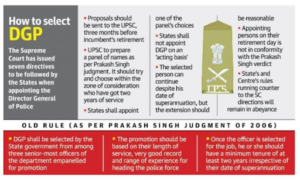In news– Recently, the Supreme Court had directed the Nagaland government to appoint the 1992-batch IPS officer as police chief. The order was passed after Nagaland challenged the UPSC’s recommendation.
Process of appointing state police chiefs-
- Appointments of Director general of police (DGPs) are now made on the basis of the Supreme Court judgement on police reforms in Prakash Singh vs Union of India in 2006.
- Based on the judgement, the UPSC issued its own guidelines in 2009 on the appointment of police chiefs of states.
- According to these guidelines, states are supposed to draw up and send to the UPSC a list of eligible officers with at least 30 years of service behind them, along with these officers’ service record, performance appraisal, and vigilance clearance.
- These officers are to be of the rank of ADG or the rank of police chief (and one below) stipulated for that state. The list is supposed to be given to UPSC six months before the incumbent DGP is to retire.
- An empanelment committee headed by the UPSC chairman, and with the union home secretary, state chief secretary, state DGP, and the chief of a central police organisation in it, is supposed to select a panel of three officers “based on merit”.
- For smaller states that may have only one cadre post of DGP, the committee is supposed to send two names.
- Under the rules, consent of an officer is not required for her posting. Also, the Centre has the power to not relieve an officer for posting in the state.
- UPSC also submitted that while the 30-year rule could be relaxed to 25 years in states like Himachal Pradesh, Manipur, Nagaland, Uttarakhand, Tripura, and Sikkim which may not have enough officers meeting this criterion, this is to be done with the consent of the Centre.
- Through two orders passed in 2018 and 2019, the SC has also stipulated that the UPSC shall not put in the panel any officer with less than six months to retirement.















